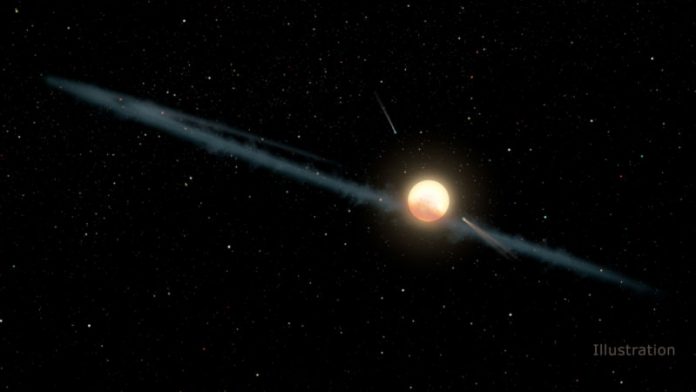A new research published this week in the Astrophysical Journal has found that an uneven ring of dust is probably to blame for the strange dimming and brightening of a star — named KIC 8462852, commonly known as Tabby’s star — located more than 1,000 light-years from Earth.
This star rose to prominence a couple years ago when scientists speculated that the dimming, which hadn’t been seen in a star before, could be due to a megastructure built around the object by some advanced alien civilization.
This explanation of the star’s seemingly odd behavior was offered up alongside other more natural ideas, but of course, the alien megastructure became the story to cling to.
The new study throws more scientific cold water on the far-out alien megastructure idea.
If some type of artificial structure were surrounding the star, it would dim light in all wavelengths equally, but that’s not what the new study found. The authors of the paper instead found that the light dims far less in infrared wavelengths when compared to ultraviolet.
“This pretty much rules out the alien megastructure theory, as that could not explain the wavelength-dependent dimming,” Huan Meng, lead author of the study, said in a NASA statement. “We suspect, instead, there is a cloud of dust orbiting the star with a roughly 700-day orbital period.”
So, it may sound like a shame that Tabby’s star probably isn’t surrounded by some huge structure built by aliens who are smarter than us, but be honest, are you really surprised?
We all get so hyped up about these kinds of alien-centric theories, but they never really pan out. One day, I hope (and think) one of these ideas will actually bear fruit, but we’re not there yet.
And the truth is, chasing one alien idea to the next will only serve to cheapen the moment when we really do figure out that we’re not alone in the universe, if that does happen someday.
Yes, this sounds ridiculous, but here’s the deal: In all likelihood, if we do find alien life, it won’t be little green men using telekinesis to build a huge star-sized structure light-years away. Instead, some robotic probe might find evidence of teeny tiny microbes on Jupiter’s moon Europa or some place close to home.
If we run from one “maybe it’s aliens” idea to the next, we’ll have a lot of fun on the internet, but, eh, I’ll wait for the real thing.















